Book contents
- Frontmatter
- Contents
- Preface
- Acknowledgements
- Part I Product innovation and strategic logic
- 1 Introduction to product innovation and new-product development
- 2 Strategic logic of product innovation
- 3 The new-product development process and organizational aspects
- Part II Establishing the foundation: the conceptual level
- Part III Methods and techniques for analysis and decision making
- Part IV The operational level and concluding remarks
- Glossary
- References
- Select bibliography
- Index
2 - Strategic logic of product innovation
Published online by Cambridge University Press: 10 August 2009
- Frontmatter
- Contents
- Preface
- Acknowledgements
- Part I Product innovation and strategic logic
- 1 Introduction to product innovation and new-product development
- 2 Strategic logic of product innovation
- 3 The new-product development process and organizational aspects
- Part II Establishing the foundation: the conceptual level
- Part III Methods and techniques for analysis and decision making
- Part IV The operational level and concluding remarks
- Glossary
- References
- Select bibliography
- Index
Summary
Introduction
The strategic logic of the organization provides the rationale for product innovation. New-product strategies and programs are based on external and internal perspectives; the business environment, the market situation, customer needs, and competitive analysis make up the external perspective, while core capabilities, core technologies, development capabilities, organizational skills and knowledge, and strategic requirements constitute the internal perspective. The business environment, market requirements, and core capabilities are primary considerations in the formulation and implementation of market-related new-product strategies.
The basic philosophy for developing sustainable new products is to create value based on the expressed and latent needs of the customers and stakeholders. The new-product development (NPD) process has to focus on finding opportunities and creating new products to delight customers and enhance long-term capabilities and prosperity.
Product innovation is established within the strategic context of the organization and its enterprise. The enterprise is the integration and alignment of the organization with all of its external constituents under the leadership of strategic management. It provides the overarching framework for understanding the opportunities and challenges in the business environment and the organization's capabilities and resources in the business context.
Strategic management determines vision, mission, and direction. Strategic direction provides the overall objectives, strategies, and action plans. The aim of strategic logic is to integrate the management system, its processes, and interrelated activities so that all initiatives and development programs flow seamlessly across the organization.
- Type
- Chapter
- Information
- Product InnovationLeading Change through Integrated Product Development, pp. 53 - 101Publisher: Cambridge University PressPrint publication year: 2005



